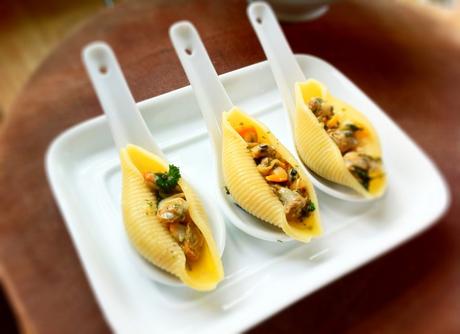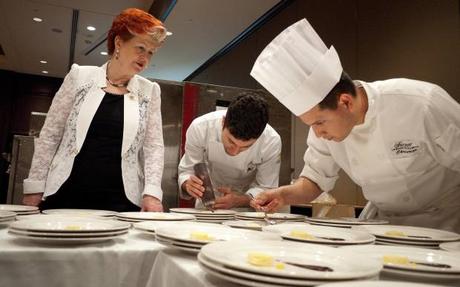Why do Chefs Tease Customers by Making Delicious Food (Amuse Bouche), but only Serving it in Small Amounts?
Nobody really knows where it all began as medieval chefs and kitchen staff for royalties and wealthy elites, although started showing the meticulous food preparation of modern times, would serve a 5-course meal in abundance and not in thrift like modern day chefs would. The Russians even have a 9-course meal for their Czars! In Europe the culinary art was pioneered by Jean Anthelme Brillat-Savarin. He is famous for the phrase, “Tell me what you eat, and I will tell you what you are,” which unintentionally became a reprimanding quote for gluttons.
In America the Boston Cooking School was the first institution to teach culinary arts that cooked more than just delicious food and this was way back in 1877. Fannie Farmer then published the Boston Cooking School Cookbook in 1896 after graduating there. The American Culinary Federation was founded in 1929 and became an assemblage of a United States Chef Club. But it wasn’t until 1946 that culinary arts became a tv show presented by Chef James Beard.
You may also want to read Top 3 Best of the Year’s Recipes from World Class Chefs

Since then culinary art has grown into the glamorous world of the food and drink industry that it is today. Now, going back to our question. It seems that chefs are interested in 3 things: 1) to tantalize diners palates with decorative, intense flavored tastings to delight the eyes, 2) prepare low calorie recipes to ensure that customers get the recommended nutrition and yet enjoy their food, and 3) to gain notoriety from their cooking prowess inspired by their artistic nature. However, despite how chefs serve food to diners in small amounts, they eventually get over a quarter of a pound of food after going through the samples, appetizers and the 5 to 9-course meals.
So Paying Hundreds of Dollars for Amuse Bouche is really all that Worth It?
Apparently customers who enjoy and appreciate the culinary arts understand that they’re not merely paying for ordinary food even if it’s delicious food. They are fully aware that the chef is an artist and artist charge huge fees for their artwork, plus some of the ingredients they use are more expensive than gold per gram! Among these include the white and black truffle which can cost $3,000 – $5,000 per pound, saffron which is sold around $6.79 – $8.29 per gram, balsamic vinegar ($100 – $400 per 3.4 fl oz), swift nest (a rare bird’s nest) where the white nest cost at least $2,000 per kilogram and the rarest of them all which is the red nest may cost up to $10,000 per kilo; are just a few to mention.
You’re not buying food ingredients from the wet or flea market here!

The other thing is the chef. He or she undergoes a certain amount of pressure to push beyond their limits in creating a recipe masterpiece for each guest. There are restaurants where you’ll never eat the same meal twice! That in itself is living proof just how much of an artist the chef is in that restaurant. So if the ingredients and the kitchen service cost this much, then don’t be surprised if they charge a seemingly unfair price for the food served at your table. In fact, if anything, they’re being very generous to you. It’s actually a privilege to dine in restaurants that have great chefs in them, because you get royalty treatment and have a nice meal that you probably won’t get anywhere else.
What is the Essence of Amuse Bouche?
The essence of amuse bouche, perhaps, is to allow the diners to explore the intricacies of their sense of taste and get a wonderful gastronomic experience at the same time. No matter what restaurant you’ll dine it or where, as long as it has a chef with a strong passion for the culinary arts, then you can be certain that they will entertain your appetite with their utmost efforts and enthusiasm. You will first hear about a certain restaurant that offers amuse bouche probably from friends, family and acquaintances as well as radio, tv and newspaper ads or on the web. Then you come at its doorsteps and see how furnished and elegant the place is. You’ll get to feel the ambiance once you’re inside and get to know their hospitality by the way the hosting staff and buspersons attend to your needs and making sure that you’re comfortable.
Once you’re seated at the table, you may get a special 5 to 9-course meal of the most delicious food they’ve prepared for that night from their menu or order something specific for your palate. The special cuisines may include cured-beet and Scottish salmon napoleon, Shrimp and grits; duck and sweet potato cannelloni; and ham and truffled eggs with moules frites; sliced seared scallop, hoosier hush puppie and more! The chef may give complimentary side dishes also and some wine to pair it with. Even if you don’t proactively give a Yelp review about the restaurant you will definitely be talking about it on Facebook or Instagram! This will add further to the already shinning status of the restaurant’s reputation on the web.

So, therefore the essence of amuse bouche is seen in 2 ways, 1) to tantalize your eyes and palate, and 2) to allow you to react and respond to the chef’s artistic renderings in his cuisines.
